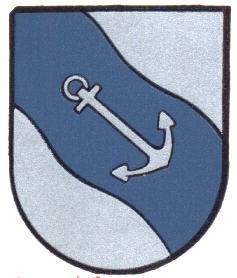Brochterbeck: Difference between revisions
Jump to navigation
Jump to search
Knorrepoes (talk | contribs) No edit summary |
Knorrepoes (talk | contribs) m (Text replace - "[[Literature" to "{{media}} [[Literature") |
||
| Line 19: | Line 19: | ||
The arms are based on the arms of the Lords of Brochterbeck, whose arms are known from the 14<sup>th</sup> century. The family became extinct in 1400. The arms showed an anchor, but colours are not known. The wavy bend was added as a canting symbol (Bach=stream) for the village. The blue colour was chosen, as it was the main colour of the County Lingen, to which the village belonged. | The arms are based on the arms of the Lords of Brochterbeck, whose arms are known from the 14<sup>th</sup> century. The family became extinct in 1400. The arms showed an anchor, but colours are not known. The wavy bend was added as a canting symbol (Bach=stream) for the village. The blue colour was chosen, as it was the main colour of the County Lingen, to which the village belonged. | ||
{{media}} | |||
[[Literature]] : Meijer, 1940 | [[Literature]] : Meijer, 1940 | ||
Revision as of 19:25, 8 July 2014
| Heraldry of the World Civic heraldry of Germany - Deutsche Wappen (Gemeindewappen/Kreiswappen) |
BROCHTERBECK
State : Nordrhein-Westfalen
District (Kreis) : Steinfurt (until 1974 Tecklenburg)
Incorporated into : 1975 Tecklenburg
Official blazon
Origin/meaning
The arms were granted on January 27, 1939.
The arms are based on the arms of the Lords of Brochterbeck, whose arms are known from the 14th century. The family became extinct in 1400. The arms showed an anchor, but colours are not known. The wavy bend was added as a canting symbol (Bach=stream) for the village. The blue colour was chosen, as it was the main colour of the County Lingen, to which the village belonged.
Contact and Support
Partners:
Your logo here ?
Contact us
© since 1995, Heraldry of the World, Ralf Hartemink 
Index of the site
Literature : Meijer, 1940











